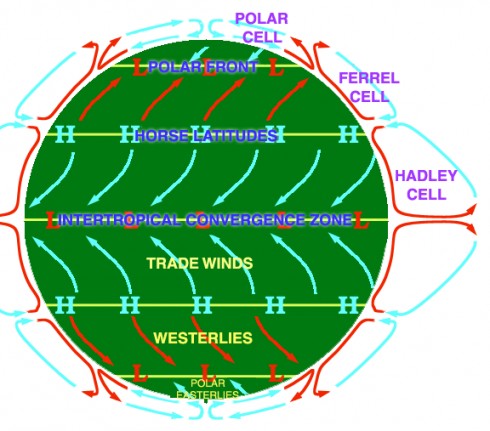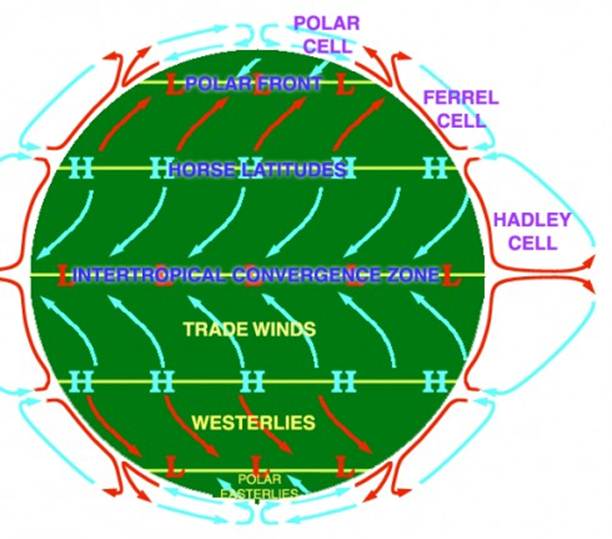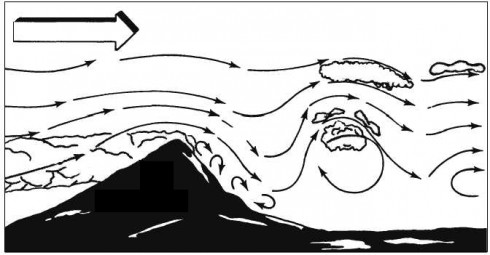Meteorology and Atmospheric Science
Homework Help & Tutoring
We offer an array of different online Meteorology and Atmospheric Science tutors, all of whom are advanced in their fields and highly qualified to instruct you.
Meteorology and Atmospheric Science
Meteorology is the study of weather. Courses in meteorology are frequently also combined with climatology - the study of climate.
Let's clarify the important difference between the two:
Weather describes the conditions of the atmosphere at a given place at a specific time. Climate describes the average conditions of the atmosphere for a given region over a long period of time.
For example: if you look outside your window in Philadelphia, PA at 4:50 pm on a Monday afternoon in January and describe what you see, you'd be talking about the weather. On the other hand, if you talk about the general tendency for it to be cold, windy, and moderately snowy during that time of year; you'd be talking about the climate.
Meteorology courses, however, do much more than describe the weather.
In your class, you'll learn the science beyond the weather you see. You'll study the process that forms rain or other forms of precipitation, for example. You'll study suchthings as fronts, low pressure systems, convection, and storm formation.
You'll also learn about the climate systems that affect the earth as a whole. One example of these is the formation of atmospheric convection cells around our planet, which drive our winds and ocean currents on a global scale. You'll learn about the seasons and what causes them, and what it might be like during "winter" or "summer" in different parts of the world.
Finally, you'll learn how latitude, how far you are from the ocean, the topography, and other physical features can impact on climate. In particular, you'll learn about the orographic effect, which makes the weather very different on one side of a mountain than the other and can even result in the formation of deserts or snow storms on only one side of a mountain.
If you're looking for current weather conditions or the science of Meteorology, and you are in the US, your first stop should be The National Weather Service or NOAA's National Weather Service Page. If you are outside the US, most countries have their own national weather service like The Met Office in the UK, which is also a great place to start. If you're not sure how to find your locale's official weather page, try searching World Weather Information Service with information from the World Meteorological Organization to find it.
Another reliable source is Weather Underground. They provide up-to-date forecasts, current weather conditions, and explanations of what's causing the weather.
There are also several large professional organizations for meteorologists. The American Meteorological Society is the largest in the US and The European Meteorological Society is the largest outside the US; although several European Countries, such as the UK also have their own. Again, The World Meteorological Organization is a good place to find your nation's professional organizations.
Let's delve into two Meteorology topics a little bit further here - atmospheric convection cells and the desertification of one side of a mountain:
Let's start with atmospheric convection cells. Take a look at the diagram below, which shows the three convection cells that extend from the equator to the north pole, known as the Hadley Cell, Ferrel Cell, and Polar Cell:

Notice that the Hadley and Polar cells circulate air counterclockwise while the Ferrel cell circulates clockwise. The question is: Why do these cells form? I will answer this question now, with the help of some rather crude diagrams that I put together using Microsoft Paint. I will upgrade the diagrams soon.
At the equator, the sun is very intense and creates a large rising air mass, as shown below:

As the air rises, it cools and becomes more dense, eventually slowing its ascent. With the rising air mass still pushing from underneath, it has no choice but to spill out in both directions at the top, as shown below:

We will ignore the air mass moving south of the equator, and concentrate on the one moving north:

As the high altitude air mass moves north, it continues to cool due to the decreasing intensity of the sun at higher latitudes. Eventually, it is dense enough that it begins to sink, and this occurs at 30o latitude, as shown below:

Once this sinking air mass reaches the ground, it has no place to go, and must split into a north-moving and south-moving air mass:

Notice we have already created a counterclockwise convection cell circulating between the equator and 30o north latitude - that is the Hadley Cell you saw in the very first diagram. As can be seen in the figure above, the air mass moving back toward the ground (the smaller blue arrow) together with the north-moving air mass (along the ground) are important because they will actually become part of the clockwise convection cell (the Ferrel Cell) that we saw circulating between 30o and 60o north latitude, so please keep this in mind as we continue.
Let's head up to the north pole and see what's going on up there. The air on top of the north pole is very cold and dense, and is therefore continuously sinking as shown below:

As before, the air mass must split when reaching the ice cap:

We will focus on the air mass moving to the right, as shown below:

The air mass is warming as it moves toward lower latitude, and at 60o has warmed enough to start rising:

Similar to what happens at the equator, the rising air mass will cool, become more dense, and eventually not be inclined to rise anymore, but as it is still being pushed up from underneath, will again split into two air masses, one moving north and one moving south, as shown below:

Notice we have now formed the counterclockwise convection cell called the Polar Cell, as well as the remaining two sides of the intermediate, clockwise-rotating Ferrel Cell. Putting it all together, we can now understand the figure we looked at in the beginning of this tutorial:

As shown above, a mirror-image of these air movement patterns is formed below the equator for exactly the same reasons, giving a complete picture of these atmospheric convection cells. Finally, the winds generated by these cells are acted upon by the rotation of the earth (Coriolis Effect), giving rise to the curved air flow patterns in the diagram above.
Now that you are an expert in atmospheric convection cells, our next question arises: why can deserts form on the leeward side of mountains? The leeward side of a mountain is the side protected from the wind. Check out the diagram below:

The leeward side is the right side, where the wind is not hitting directly as it is on the left, or windward side. As the air moves up the windward side, it cools to the point where the water vapor molecules condense into rain, and perhaps farther up, into snow. Having left all it's moisture on the windward side, it's easy to understand why the leeward side is dry.
So far, so good. Let's say the ground air temperature on the left side of the mountain is 70oF. On the right side of the mountain, ground temperatures are likely to be around 100oF or more. The question we are trying to answer here is why does the air on the leeward side reach much higher temperatures than the air on the windward side? The answer has to do with the property of a substance called its specific heat capacity, or simply its heat capacity. Let's understand what this is before we come back to our mountain.
There are many types of energy - mechanical, electrical, magnetic, and thermal, just to name a few. We are interested here in thermal energy. Lets just say that the thermal energy of a system is related to its temperature. If you add thermal energy to a system, its temperature will rise. If you remove thermal energy from a system, its temperature will fall.
The heat capacity of a substance is the amount of thermal energy required to change its temperature. Water, for example, happens to have a large heat capacity relative to most other substances, which means that you have to add (or remove) quite a bit of thermal energy in order to raise (or lower) its temperature.
Now think about moist air and dry air. Moist air contains water vapor, whereas dry air does not. So, we would expect that if we add the same amount of thermal energy to similarly-sized samples of moist and dry air, the moist air will not reach as high a temperature as the dry air because most of the energy we are adding is being absorbed by the water molecules with little change in their temperature as a result of their large heat capacity. The dry air sample will end up at higher temperature since all the energy is absorbed by molecules of nitrogen and oxygen that have lower heat capacities than water. By exactly the same reasoning, if we remove the same amount of thermal energy from moist and dry air, the moist air will not reach as low a temperature as the dry air.
What we realize in the discussion above is that moist air changes temperature much less easily than dry air, due to the large heat capacity of the water molecules in moist air. Since the altitude change is the same on both sides of the mountain, the pressure change is of the same magnitude going up and coming down. Pressure changes are the mechanism through which we add or remove thermal energy from air samples, because an increase in pressure causes the molecules to move closer together which in turn produces heat due to friction.
As the air moves up the mountain, the lower pressures act to remove thermal energy from the air; as the air moves down the other side, the higher pressures act to add thermal energy to the air. As mentioned above, the altitude changes are the same, so we are in fact reproducing the experiment above with moist and dry air. The dry air will change temperature more as it heats up moving down the mountain as compared to the moist air cooling off as it moves up. So, we will have much hotter temperatures on the leeward side of the mountain, and the combination of hot and dry is the very definition of a desert ecosystem.
To fulfill our tutoring mission of online education, our college homework help and online tutoring centers are standing by 24/7, ready to assist college students who need homework help with all aspects of meteorology and atmospheric science. Our earth science tutors can help with all your projects, large or small, and we challenge you to find better online meteorology and atmospheric science tutoring anywhere.
College Meteorology and Atmospheric Science Homework Help
Since we have tutors in all Meteorology and Atmospheric Science related topics, we can provide a range of different services. Our online Meteorology and Atmospheric Science tutors will:
- Provide specific insight for homework assignments.
- Review broad conceptual ideas and chapters.
- Simplify complex topics into digestible pieces of information.
- Answer any Meteorology and Atmospheric Science related questions.
- Tailor instruction to fit your style of learning.
With these capabilities, our college Meteorology and Atmospheric Science tutors will give you the tools you need to gain a comprehensive knowledge of Meteorology and Atmospheric Science you can use in future courses.
24HourAnswers Online Meteorology and Atmospheric Science Tutors
Our tutors are just as dedicated to your success in class as you are, so they are available around the clock to assist you with questions, homework, exam preparation and any Meteorology and Atmospheric Science related assignments you need extra help completing.
In addition to gaining access to highly qualified tutors, you'll also strengthen your confidence level in the classroom when you work with us. This newfound confidence will allow you to apply your Meteorology and Atmospheric Science knowledge in future courses and keep your education progressing smoothly.
Because our college Meteorology and Atmospheric Science tutors are fully remote, seeking their help is easy. Rather than spend valuable time trying to find a local Meteorology and Atmospheric Science tutor you can trust, just call on our tutors whenever you need them without any conflicting schedules getting in the way.


